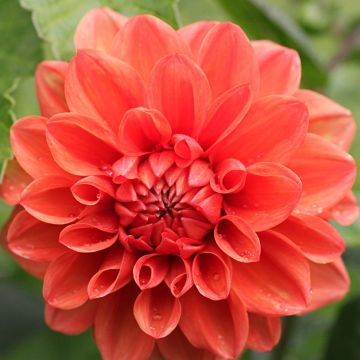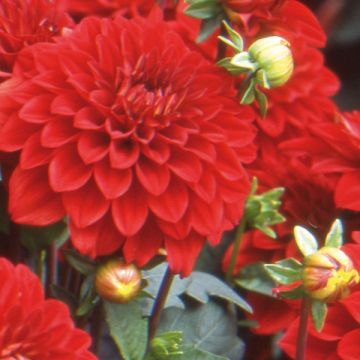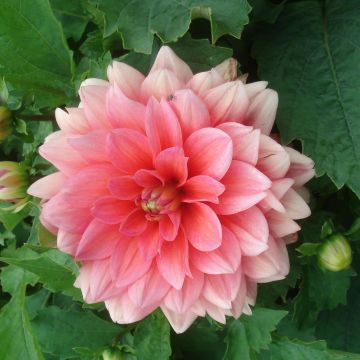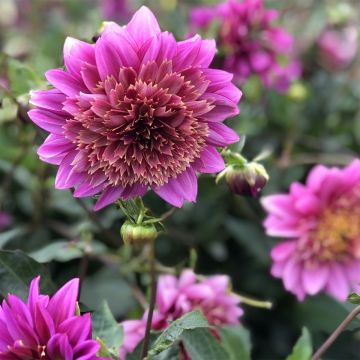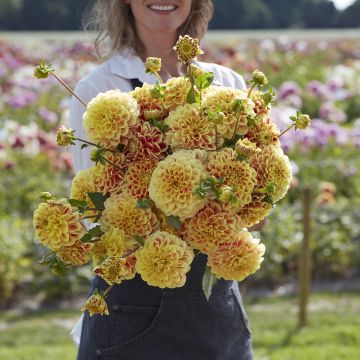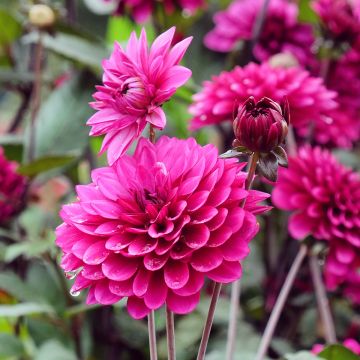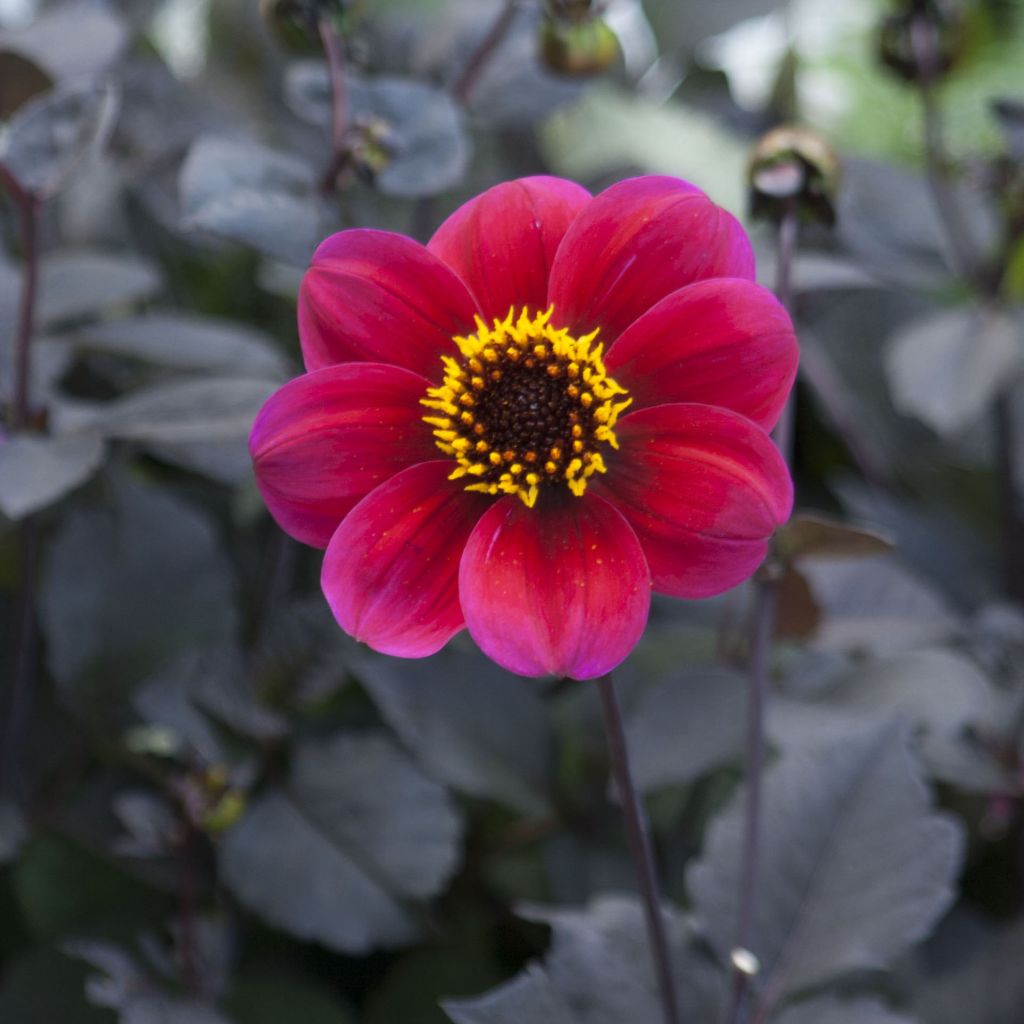

Dahlia Roxy
Dahlia Roxy
Dahlia Roxy
Dahlia
Gorgeous dahlia. Bright pink. Simple yet very cute flower. Bumblebees love it as much as I do.
Florence, 27/03/2023
Why not try an alternative variety in stock?
View all →This plant carries a 6 months recovery warranty
More information
We guarantee the quality of our plants for a full growing cycle, and will replace at our expense any plant that fails to recover under normal climatic and planting conditions.
From €5.90 for pickup delivery and €6.90 for home delivery
Express home delivery from €8.90.
Does this plant fit my garden?
Set up your Plantfit profile →
Description
The Pretty Dahlia 'Roxy' is an adorable plant, small in size but remarkably colourful. This fairly old variety never fails to charm generations of gardeners with its simple flowers, displaying an extraordinary mid-red to magenta pink colour, centred around a golden to brown heart. They are enhanced by dark foliage and stems, with green-purple tones, sometimes tinged with crimson. The very compact plant creates a colourful bouquet for 4 to 5 months, adding a personal and cheerful touch to sunny borders and planters.
Dahlias belong to the asteraceae family and are originally from the high plateaus of Mexico. At present, the approximately 25,000 horticultural varieties obtained by humans have invaded, to our great pleasure, gardens all over the world.
The 'Roxy' variety, introduced in Germany in 1964, is a Dahlia classified in a separate category, that of Pretty Dahlias, characterized by flowers composed of a crown of wide, flat petals revealing the yellow heart. It is also part of the dwarf dahlias, as it will not exceed 40-45 cm (16-18in) in height and 30 to 40 cm (12 to 16in) in width. The flowers of 'Roxy', with 8 petals curved inwards at their tips, are less than 10 cm (4in) in diameter. Their colour, somewhat difficult to describe, is an extremely deep pink, inhabited by red to wine-red nuances. The tiny flowers at the heart form a very visible golden disc. Flowering occurs from July to October. The habit is bushy and upright. The highly branched stems are hollow and the leaves are opposite, pinnately divided into 3 or 5 very toothed lobes. The leaves and stems have a beautiful dark green-bronze-purple hue.
To promote flower re-occurrence, take care to remove faded flowers, or even better, regularly make large colourful bouquets by combining it with other varieties. 'Roxy' pairs particularly well with the grey foliage of artemisias (Artemisia Powis Castle, Artemisia absinthium Lambrook Silver, Silver Dust Cineraria), golden foliage or dark needles of certain small conifers (Thuja occidentalis 'Golden Globe', Chamaecyparis obtusa Chirimen, Chamaecyparis obtusa Juniperoides). In the front of borders, in informal borders or even in pots on the terrace, this Dahlia will create colourful and original spots in the company of white asters (Aster Ashvi), light blue or mauve flowers (Aster cordifolius, Aster turbinellus, Aster novi-belgii Marie Ballard) for example. Its flowers are of course magnificent in bouquets.
The star plant of borders and herb gardens, Dahlias confidently accompany the most beautiful flowers but are also appreciated alongside vegetable plants. In Mexico, this tuberous plant was first cultivated as a root vegetable for consumption. But its poor taste qualities relegated it to the status of an ornamental plant. Since then, interest in their beautiful exuberance has never waned.
Report an error about the product description
Dahlia Roxy in pictures




Plant habit
Flowering
Foliage
Botanical data
Dahlia
Roxy
Asteraceae
Dahlia
Cultivar or hybrid
Other Dwarf Dahlias
Planting and care
The Dahlia 'Roxy' is easy to grow in all regions. For abundant flowering, it is good to follow a few simple rules. Plant the tubers in a sunny location as soon as the last frosts have passed. Rich, fresh, and well-drained soils are perfect. However, stagnant moisture would promote tuber rot. Do not hesitate to amend the soil with compost and sand if necessary. Work the soil deeply and enrich it, for example, with crushed horn or dehydrated blood. Place your tuber and crumble the soil well to fill without air pockets. Your dahlia should be covered with about 6 cm (2in) of soil. At the end of planting, water once abundantly, then repeat this watering regularly during the first 6 weeks to help with rooting.
Dahlias are sensitive to cold, so they often need to be overwintered. In November, the first frosts cause the foliage to turn black, which is the time to dig them up. Carefully remove the tubers, taking off as much soil as possible. Let the foliage dry so that the tubers can replenish their reserves. Then cut the stems to 10 cm (4in). Spread your bulbs in a crate on newspaper. Store them in a frost-free, dry, cool, and dark place, such as a garage or attic. In regions of the South, close to the coast, where there are only a few days of frost per year and moderate frosts (-5 to -10°C (23 to 14°F)), it is possible to leave them in place. In this case, simply cover the ground with a carpet of leaves or straw for protection.
Planting period
Intended location
Care
-
, onOrder confirmed
Reply from on Promesse de fleurs
Dahlias
Haven't found what you were looking for?
Hardiness is the lowest winter temperature a plant can endure without suffering serious damage or even dying. However, hardiness is affected by location (a sheltered area, such as a patio), protection (winter cover) and soil type (hardiness is improved by well-drained soil).

Photo Sharing Terms & Conditions
In order to encourage gardeners to interact and share their experiences, Promesse de fleurs offers various media enabling content to be uploaded onto its Site - in particular via the ‘Photo sharing’ module.
The User agrees to refrain from:
- Posting any content that is illegal, prejudicial, insulting, racist, inciteful to hatred, revisionist, contrary to public decency, that infringes on privacy or on the privacy rights of third parties, in particular the publicity rights of persons and goods, intellectual property rights, or the right to privacy.
- Submitting content on behalf of a third party;
- Impersonate the identity of a third party and/or publish any personal information about a third party;
In general, the User undertakes to refrain from any unethical behaviour.
All Content (in particular text, comments, files, images, photos, videos, creative works, etc.), which may be subject to property or intellectual property rights, image or other private rights, shall remain the property of the User, subject to the limited rights granted by the terms of the licence granted by Promesse de fleurs as stated below. Users are at liberty to publish or not to publish such Content on the Site, notably via the ‘Photo Sharing’ facility, and accept that this Content shall be made public and freely accessible, notably on the Internet.
Users further acknowledge, undertake to have ,and guarantee that they hold all necessary rights and permissions to publish such material on the Site, in particular with regard to the legislation in force pertaining to any privacy, property, intellectual property, image, or contractual rights, or rights of any other nature. By publishing such Content on the Site, Users acknowledge accepting full liability as publishers of the Content within the meaning of the law, and grant Promesse de fleurs, free of charge, an inclusive, worldwide licence for the said Content for the entire duration of its publication, including all reproduction, representation, up/downloading, displaying, performing, transmission, and storage rights.
Users also grant permission for their name to be linked to the Content and accept that this link may not always be made available.
By engaging in posting material, Users consent to their Content becoming automatically accessible on the Internet, in particular on other sites and/or blogs and/or web pages of the Promesse de fleurs site, including in particular social pages and the Promesse de fleurs catalogue.
Users may secure the removal of entrusted content free of charge by issuing a simple request via our contact form.
The flowering period indicated on our website applies to countries and regions located in USDA zone 8 (France, the United Kingdom, Ireland, the Netherlands, etc.)
It will vary according to where you live:
- In zones 9 to 10 (Italy, Spain, Greece, etc.), flowering will occur about 2 to 4 weeks earlier.
- In zones 6 to 7 (Germany, Poland, Slovenia, and lower mountainous regions), flowering will be delayed by 2 to 3 weeks.
- In zone 5 (Central Europe, Scandinavia), blooming will be delayed by 3 to 5 weeks.
In temperate climates, pruning of spring-flowering shrubs (forsythia, spireas, etc.) should be done just after flowering.
Pruning of summer-flowering shrubs (Indian Lilac, Perovskia, etc.) can be done in winter or spring.
In cold regions as well as with frost-sensitive plants, avoid pruning too early when severe frosts may still occur.
The planting period indicated on our website applies to countries and regions located in USDA zone 8 (France, United Kingdom, Ireland, Netherlands).
It will vary according to where you live:
- In Mediterranean zones (Marseille, Madrid, Milan, etc.), autumn and winter are the best planting periods.
- In continental zones (Strasbourg, Munich, Vienna, etc.), delay planting by 2 to 3 weeks in spring and bring it forward by 2 to 4 weeks in autumn.
- In mountainous regions (the Alps, Pyrenees, Carpathians, etc.), it is best to plant in late spring (May-June) or late summer (August-September).
The harvesting period indicated on our website applies to countries and regions in USDA zone 8 (France, England, Ireland, the Netherlands).
In colder areas (Scandinavia, Poland, Austria...) fruit and vegetable harvests are likely to be delayed by 3-4 weeks.
In warmer areas (Italy, Spain, Greece, etc.), harvesting will probably take place earlier, depending on weather conditions.
The sowing periods indicated on our website apply to countries and regions within USDA Zone 8 (France, UK, Ireland, Netherlands).
In colder areas (Scandinavia, Poland, Austria...), delay any outdoor sowing by 3-4 weeks, or sow under glass.
In warmer climes (Italy, Spain, Greece, etc.), bring outdoor sowing forward by a few weeks.

































